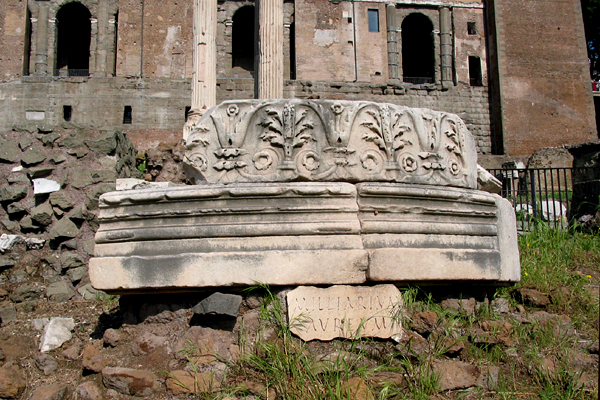
"...he [Otho] went away, and passing through what was called the house of Tiberius, went down into the forum, to where a gilded column stood, at which all the roads that intersect Italy terminate."
Plutarch, Life of Galba (XXIV.4)
In 20 BC, Augustus was appointed superintendent (cura viarum) of the road system of Rome and its environs, and "in this capacity set up the golden mile-stone, as it was called" (Dio, LIV.8.4). The Milliarium Aureum, a column of gilded bronze (or marble clad in gilt bronze), was regarded as the point from which all the principle roads of Rome diverged.
It stood in the Forum, probably between the Rostra and the Temple of Saturn (Pliny, III.66), although its foundations has not been located. Nor does the circular marble plinth decorated with an anthemion (palmettes entwined with lillies) identified as the Milliarium Aureum necessarily belong to the original base, as it would seem too large for a milestone unless it were truly monumental. Rather, a circular concrete base found at the corner of the Rostra in 1959 may be a better attribution.
In AD 69, the Milliarium Aureum was used as a rendezvous, and Suetonius (Otho, VI.2), Tacitus (Histories, I.27), and Plutarch quoted above, all speak of Otho making an excuse to take his leave of Galba and going to the Forum to accept the acclaim of his bodyguard as emperor at "the Golden Milestone near the Temple of Saturn."

Each gate in the Aurelian Wall was named for the road that passed through it. This milestone on the Via Appia is situated outside the Porta Appia (modern Porta San Sebastiano) and marks the first Roman mile (as measured from the ancient Porta Capena) on that road. One still can read the names of Vespasian and Nerva, who made repairs in AD 97. |
The Roman mile consisted of one thousand paces (millia passuum). This distance was marked by milestones (milliaria), pillars typically inscribed with the distance (the number prefixed by MP), the places between which the road extended, who constructed the road, and the emperor to whom it was dedicated. It is likely that the Milliarium Aureum was similar in form to these milestones and may have contained much of the same information, viz., the names of the principal cities and their distances from Rome, as measured from the city gates. But this is only an inference. Nor is it certain whether miles were reckoned from the Milliarum Aureum or the gates of the city. It may be, too, that the names of ex-praetors (curatores viarum) appointed by Augustus to supervise the construction of the roads were inscribed on the column (Dio, LIV.8.4).
That Gracchus marked the road with milestones is not to say, however, that they had not been used before. Polybius, for example, commenting on the road from Narbo (Narbonne) to the Rhone, remarks that it had "now been carefully measured by the Romans and marked with milestones at every eighth stade" (III.39) |